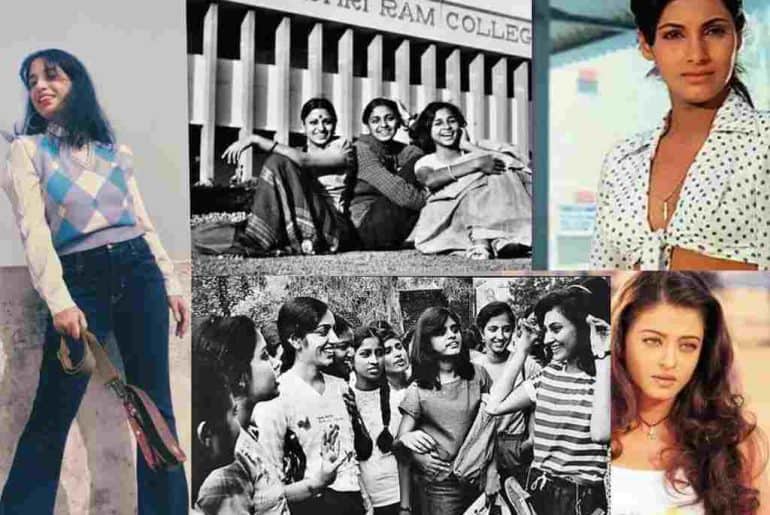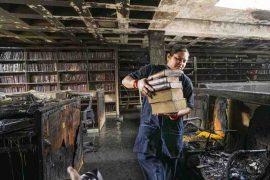Let’s take a trip down the memory lane and explore different facets of fashion in the post-independence era in the most celebrated pedagogical campus of India.
Delhi University, the most prestigious university in the country also boasts of hosting a wildly diverse student body. The colleges of DU spread all over the national capital have for over a hundred years produced a pedigree of students which have gone on to excel in all sorts of fields. This diversity in culture, ethnicity and identities has facilitated the existence of a vibrant fashion culture in the university.
Umberella shaped sorts of Kurtas without cuts on the side. They were pretty trendy but walking and running around in those was a bit arduous. We paired these with tight pajamas. In the 60s very few ‘mod’ women wore pants. Most girls either made a simple plait or huge high buns with puff stuffed within”, an alumna of IPCW, Batch’62.
Owing to her back to back hits with Junglee, Bluff Master, Ayee Miyan ki Belan, Padosan and plenty more in the 60s, Saira Banu and her style became a cult classic for the youngsters. Her high placed classic bun with a middle partitioned hairline, dramatic winged eyeliner and tight fitted sarees were celebrated and greatly imitated by most young women back then. Almost everyone wanted to look like her, dress like her.
Popular footwear included Canvas sneakers, T-strap sandals with tiny heels, one toe flats from Janpath or the basic slip-ons from Bata. Archives from websites of DU colleges like LSR and Miranda shows women practicing their P.T drill in tight fitted suits with thin strap slippers on.
By late 60s several new all-women’s colleges had been established, thereby bolstering the admission rate of women into Delhi University. This gave space for their style to acquire a bolder and more liberal facet.
Fashion meant a lot to us back then. With tight fitted shirts, churidar pajamas, full length wrap around skirts, pleated pants and bouffant hairdos with backcombed puffs, we all put our best foot forward when dressing up for college. We didn’t wear revealing clothes but our tops and kurtas were tight fitting”, shares an LSR alumna, batch’1967.
Dr Prabha Jain, an alumna of Lady Hardinge Medical College, MBBS Batch’72 recounts,
As far as I can recall, my college, unlike other DU colleges had certain restrictions on what we all chose to wear – especially the anatomy department. Most girls barring a few wore either sarees or kurta and salwar. Our suits were either sleeveless or tightly fitted, but were all cloaked under our Doctor’s Apron. Our go to shopping place was Karol Bagh – going to Chandni Chowk seemed too daunting because of the rush, and CP was too expensive for us back then”.
“Everything flared” was definitely the fashion tagline of the 70s. This decade had the youngsters drooling over bell bottoms and bell sleeve printed tops. Neetu Singh, Zeenat Aman and Sharmila Tagore were the biggest fashion icons of this age. Dimple Kapadia’s cropped polka dots white front tie top in Bobby resulted in the print being labeled as the ‘hallmark of 70s Fashion’. Denim was formally introduced in the same decade through Veeru (Dharmendra) and Jai’s (Amitabh Bachan) denim jeans and shirts in the blockbuster – Sholay. Nonetheless denim jeans in the common population only became a staple towards the late 80s.
We wore extremely deep cut bell bottoms with embroidered patterns at the lower helm. Styled those with cropped tops with a shrug on top, if not cropped then they would be longer. We occasionally also wore corduroy knee length shorts, not often. Pre-made dhotis with short kurtis and chiffon duppattas had gotten pretty famous. Chand Baliyan, dainty neck pieces, big buns and winged eye liners – we have done and loved them all”, says Ranjana Kohli, a Maitreyi College alumna, Batch’74.
By end 70s/early 80s, owing to it’s pan-India nature, DU had definitely developed itself into a melting pot for different cultures, identities and even fashion styles. Student from different parts of the country, from different backgrounds, ethnicities, elite boarding schools, public schools, rich and not-so rich families came together in one city. This facilitated interaction of faiths and ideologies, and was one major factor behind the fact that Delhi became “mod” (slang for modern) in terms of fashion quite sooner than other major cities.
Gautam Kalra, a 1991 DU graduate mentions,
80’s was all about loud fashion, neons, permed hair, bleached hair, plastic jewellery. Students wore a lot of unaesthetic synthetic clothing. 1991-1993, then I went to Delhi School of Economics for post-grad – which was more intellectual and saw a lot of toppers from Presidency college & Stephens. The vibe was Anti-fashion with tailor-made trousers clad nerdy under-dressed people sporting jhola bags and reading glasses. I however continued serving individuality and wore the then cool Bermuda shorts with T-shirts, fake ysL blue reading glasses, plenty of colour and denim”.
The popularity of flared pants and bell bottoms waned towards late 80s and was replaced by straight-fit or bootcut trousers. The 80s and 90s also witnessed an overwhelmingly crazy obsession with denim jeans. George Michael’s typical cross jetted pocketed loose jeans and the multi-pocketed ones were the most sought after styles in denim. 90s brought in the obsession with Salman Bhai’s shirtless look with tattered baggy jeans on in O O Jaane Jana. DU students usually wore jeans from indigenous brands like wrangler or locally sourced them from second-hand markets in Sarojini. International brands like Benetton and Levis became popular among the youth only after mid 90s, post liberalization.
We didn’t really have the kind of influencers you have today on Social Media. We derived our fashion inspiration from movie actresses and pop icons of our time. Luckily for us stereotypically skinny framed girls, Sonali Bendre popularized the ‘skinny’ body type. Madhuri was definitely a cult favorite in the 90s”, says an alumna of Hindu College, Batch’92
This obsession with Madhuri Dixit is implicit in the fact that in the early 90s, almost everyone was trying to emulate her shoulder length, wavy, voluminous, side portioned puff. The impact Madhuri’s purple lehenga with it’s backless blouse in ‘Hum Aapke hai kaun’ was ineffable to the extent that most girls insisted on wearing a similar design for their farewells and other college functions.
The movie “Aashiqui” was all the rage in early 90s. The amount of influence the movie had on everyone back then was overwhelmingly crazy. All the boys in a bid to look like Rohan Roy started maintaining a longer mane and the girls would run to the local tailor to improvise their own versions of Anu Agarwal’s famous white lace navy blue dress. Her polka dots net ribbons had a separate fan base altogether.
Jeans were in, shirts without sleeves were in, but crop tops or any shirts that showed the stomach were still a bold fashion statement. I was rather a plain Jane. So I knew little about makeup and fashion trends. But, Kajal, lipsticks and liners were always a staple for most. Reebok, Adidas sports shoes and Woodland were the flavours of the season”, says Sarika Salil, an English (Hons.) graduate from Hansraj College, Batch’97.
She continues to highlight the darker side of this flourishing period of fashion in India,
People were body-shamed openly and brazenly. Anyone who was considered ‘fat’ according to the rigid beauty standards had to stick to the ‘conservative’ fashion trends, and donned only salwar kameez. They avoided jeans and short blouses because of the persistent comments on their bodies”.
90s was also the time when Aviators gained huge love among the youngsters – especially men. This love can greatly be attributed to Tom Cruise’s look in Top Gun. Only some could afford the real OG Raybans aviators, others managed it with dupes. Women bought more of oval shaped, narrow framed sunglasses. These have made a comeback in recent years. Around this time, the baggy multi-pocketed denims had been discarded for high waist straight-fit bootcut jeans. The aesthetic became cleaner and more sophisticated.
Devika Ahluwalia, who graduated from Venkys in the summer of 98’ remarks,
‘Fashion’ in college for me was on the one hand about kohlapuri chappals and comfy kurtas to slightly cropped belly button showing cotton sleeveless tops over comfy pants. Mismatched laces on cloth trainers (not sure I could afford Converse then) along with shirts tied at the waist over a flared skirt made sense to me at the time. As did cutting off the bottom of t-shirts to make them shorter”,
she continues
Sarojini Nagar export clothes reject market was a monthly hang out for good fashion reject bargains. My hair was long and not “styled” and a pencil was used when I tied it into a bun. Silver jewellery passed/gifted to me by my sister was a part of my daily look. As was kajal and slightly thin eyebrows. Going out at night meant borrowing clothes from friends who had the access to their ‘abroad’ shopping. Tight short skirts and even tighter tops came out of the closet for those times”.
The 2Ks were an era of tube tops, low rise denims, Aishwarya’s dressy dainty micro tops, Poo’s sexy fusion of indo-western elements, the tiniest mini-skirts, natural looking blow dried hair and dangly earrings. All thanks to Juicy’s tracksuits popularized by Britney, the Kardashians and Paris Hilton; and in the Indian context Karishma’s outfits in Dil toh Pagal hai and SRKs wardrobe from Kuch Kuch Hota Hai resulted in a new found love for athleisure. Late 90s and early 2000s was also the golden period for India in International pagents. Back to back wins by Diana Hayden, Yukta Mookhey, Lara Dutta, Priyanka Chopra and Dia Mirza. There was a global recognition and acknowledgement of the Indian beauties globally. Their fashion etiquettes and aesthetics were largely emulated by young college going women. The 2000s also saw a crazy obsession with the front hair being styled into a pouf. Everyone was getting their hair cut into steps or layers.
The DU fashion trends while segueing it’s way into the early 2010s from 2Ks transitioned from bootcut to strechy skinny jeans, low rise to high waisted multiple buttoned denims, from glossy liquid lipsticks to baby lips, crop tops to T-shirts, pencil heels to wedges. Jeggings replaced jeans and was worn under kurtas or loose T-shirts. Short kurtis with harem pants, Punjabi juttis paired with silver jhumkas and bangles from lajpat or janpath was the new staple in DU colleges.
We were obsessed with using baby lips and excessive Kajal. We had luckily stopped with the puffs in 2012 but the side parting was huge. Jeggings and crop tops were fashion in 2015-16”, says Selina, an alumna of Lady Irwin College, Batch’2016.
Today’s DU fashion is an astounding amalgamation of fashion aesthetics of different decades, cultures and identities. From the effortlessly chic clean girl activewear, to Y2ks big pants small tops, big T-shirts small shorts, kurta and pajama, crop tops and pajamas, summer midi dresses, dark academia inspired deep shade pleated skirts, Sarojini ke jhumke, Lajpat’s western jewellery, from nike sneakers to ‘kohlapuri chappals’ from janpath to crocs, from H&M, Zara apparels to their dupes and rejects from Sarojini, – us DU students can style all of these effortlessly.
Fashion today is not a mere display of vanity or simply about putting on random trending pieces of clothing. Yes, we do feed on trends and contribute to the fast fashion capitalist economy in a lot of ways, but still, Fashion today has a lot more to do with self-expression, comfort and acceptance.
Fashion for me is acceptance. It is finding solace in the fact, especially in an all-girls college, that no matter what you wear, no one will judge you. There’s always going to be someone more over-dressed or under-dressed than you are. One can walk into the campus wearing a saree and no one will bother, one only appreciates”, says Dolijung Negi, a final year student from LSR.
A lot of current DU students agree that the fashion today doesn’t necessarily coerce one into opting into a particular vertical of trend, but instead, thanks to the diversity in aesthetics one doesn’t necessarily feel alienated and ends up discovering their own fashion sense and learns to celebrate it’s uniqueness.
Rubani Sandhu





Comments are closed.